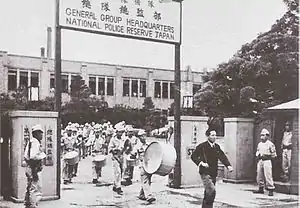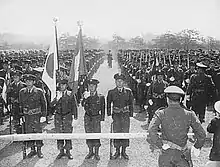National Police Reserve
The National Police Reserve (警察予備隊, Keisatsu Yobitai), or NPR, was a lightly armed national police force established in August 1950 during the Allied occupation of Japan.[2] In October 1952, it was expanded to 110,000 men and renamed as the National Safety Force. On July 1, 1954, it was reorganized as the Japan Ground Self-Defense Force (JGSDF).
| National Police Reserve (NPR) | |
|---|---|
| 警察予備隊 | |
 NPR insignia | |
| Active | 10 August 1950–1 July 1954 |
| Country | |
| Role | Paramilitary Armed Police |
| Size | c. 75,000 – 110,000 |
| Part of | Prime Minister's Office |
| Garrison/HQ | Camp Etchūjima, Kōtō, Tokyo |
| Commanders | |
| Notable commanders | Senior Superintendent Keizō Hayashi[1] |
History

On the outbreak of the Korean War, many units of the United States Armed Forces stationed in Japan were transferred to South Korea for combat, and Japan was perceived as lacking defenses.[3][4][2] Encouraged by the Supreme Commander for the Allied Powers (GHQ), the Japanese government in 1950 authorized the establishment of NPR, consisting of 75,000 men equipped with light infantry weapons.[5][4] Personnel affairs of the NPR was taken charge of by GHQ's Government Section (GS) under Brigadier General Courtney Whitney[6] while the efforts to establish and train the force was made by Civil Affairs Section Annex (CASA) under Major General Whitfield P. Shepard.[7][1]
Given the legal status of police, the National Police Reserve was tasked with the duty to maintain public security under special conditions according to the National Police Reserve Order (Cabinet Order No. 260, 1950),[n 1] while in terms of unit formation and equipment, it was a de facto military force modeled after the United States Army.[10]
In October 1952, the NPR was expanded to 110,000 men and renamed as the National Safety Force (NSF).[11][12][13]
On July 1, 1954, after the 1954 Self-Defense Forces Act [Act No. 165 of 1954] the National Security Board was reorganized as the Defense Agency, and the National Security Force was reorganized as the Japan Ground Self-Defense Force (postwar army branch of Japan),[14] while the Coastal Safety Force (waterborne counterpart of the NPR) was reorganized as the Japan Maritime Self-Defense Force (postwar naval branch of Japan).[15][16]
Ranks

.svg.png.webp)
| NPR ranks | equivalent Army/JGSDF ranks[17] | ||
|---|---|---|---|
| in Japanese | English translations | ||
| Officers | Keisatsukan (警察監)[18] | Senior Superintendent[1] | Lieutenant General |
| Keisatsukanho (警察監補) | Assistant Senior Superintendent | Major General | |
| Ittō keisatsusei (1等警察正)[19] | Superintendent First Class[20] | Colonel | |
| Nitō keisatsusei (2等警察正)[21] | Superintendent Second Class[22] | Lieutenant Colonel | |
| Keisatsushicyō (警察士長)[21] →Santō keisatsusei (3等警察正) | Senior Inspector[22] →Superintendent Third Class | Major | |
| Ittō Keisatsushi (1等警察士)[21] | Inspector First Class[22] | Captain | |
| Nitō Keisatsushi (2等警察士)[18] | Inspector Second Class[1] | First lieutenant | |
| Santō Keisatsushi (3等警察士) | Inspector Third Class | Second lieutenant | |
| Sub-officers | Ittō Keisatsushiho (1等警察士補) | Assistant Inspector First Class | Master Sergeant |
| Nitō Keisatsushiho (2等警察士補) | Assistant Inspector Second Class | Sergeant First Class | |
| Santō Keisatsushiho (3等警察士補) | Assistant Inspector Third Class | Sergeant | |
| Patrolmen | Keisachō (警査長) | Senior Patrolman | Leading Private |
| Ittō Keisa (1等警査) | Patrolman First Class | Private First Class | |
| Nitō Keisa (2等警査)[23] | Patrolman Second Class[24] | Private | |
Photos
 National Police Reserve Corps, (Showa 27) May 3, 1952
National Police Reserve Corps, (Showa 27) May 3, 1952 Police Reserve Corps 1st Regiment
Police Reserve Corps 1st Regiment A police officer of a police reserve party who will face the first morning assembly after commissioning
A police officer of a police reserve party who will face the first morning assembly after commissioning NPR bazooka training
NPR bazooka training
Notes and references
Notes
- According to Article 3, National Police Reserve Order (警察予備隊令第三條), the NPR took action upon appointment by the Prime Minister when it was particularly necessary to maintain public security.[8] (original text in Japanese: 警察予備隊は、治安維持のため特別の必要がある場合において、内閣総理大臣の命を受け行動するものとする。)[9]
References
- Kuzuhara 2006, p. 99.
- Kuzuhara 2006, p. 95.
- 佐道明廣 2017, p. 36.
- 佐道明広 2006, p. 23.
- Kuzuhara 2006, p. 96.
- Maeda 1995, p. 25.
- 华丹 2014, p. 22.
- 佐道明廣 2017, p. 37.
- 松本昌悦, 尾崎利生 & 箭川哲 1988, p. 475.
- 佐道明廣 2017, p. 37-38.
- 佐道明広 2006, p. 32.
- 华丹 2014, p. 30.
- 赫赤, 关南 & 姜孝若 1988, p. 189.
- Kowalski 2014, p. 72.
- Takei 2008, p. 3.
- 武居智久 2008, p. 5.
- 防衛庁 2004, p. 266.
- 葛原和三 2006, p. 83.
- 葛原和三 2006, p. 89.
- Kuzuhara 2006, p. 107.
- 葛原和三 2006, p. 87.
- Kuzuhara 2006, p. 104.
- 葛原和三 2006, p. 82.
- Kuzuhara 2006, p. 98.
References
- Maeda, Tetsuo (1995). The Hidden Army: The Untold Story of Japan's Military Forces. Edition Q. ISBN 9781883695019.CS1 maint: ref=harv (link)
- Kowalski, Frank (2014). An Inoffensive Rearmament: The Making of the Postwar Japanese Army. Naval Institute Press. ISBN 9781591142263.CS1 maint: ref=harv (link)
- Kuzuhara, Kazumi (2006). "The Korean War and The National Police Reserve of Japan: Impact of the US Army's Far East Command on Japan's Defense Capability" (PDF). NIDS Journal of Defense and Security. National Institute for Defense Studies. No. 7. ISSN 1345-4250. Archived from the original (pdf) on 6 June 2016.CS1 maint: ref=harv (link)
- Takei, Tomohisa (2008). "Japan Maritime Self Defense Force in the New Maritime Era" (PDF). Hatou. Hatou. 34. Archived from the original (pdf) on 15 December 2018.CS1 maint: ref=harv (link)
- (in Japanese)武居智久 (2008). 海洋新時代における海上自衛隊 [Japan Maritime Self Defense Force in the New Maritime Era] (PDF). 波涛. 波涛編集委員会. 34. Archived from the original (pdf) on 15 December 2018.CS1 maint: ref=harv (link)
- (in Japanese)葛原和三 (2006). 朝鮮戦争と警察予備隊:米極東軍が日本の防衛力形成に及ぼした影響について (PDF). 防衛研究所紀要. 防衛研究所. 8 (3). Archived from the original (pdf) on 2015-11-23.CS1 maint: ref=harv (link)
- (in Japanese)松本昌悦; 尾崎利生; 箭川哲 (1988). 原典 日本憲法資料集. 創成社. ISBN 978-4794440082.CS1 maint: ref=harv (link)
- (in Japanese)佐道明広 (2006). 戦後政治と自衛隊. 吉川弘文館. ISBN 4-642-05612-2.CS1 maint: ref=harv (link)
- (in Japanese)防衛庁 (2004). "自衛隊の階級" [Ranks of the JSDF]. 平成16年版 防衛白書 [Defense of Japan 2004] (PDF). Archived from the original (PDF) on 2013-07-27. Retrieved 2018-04-09.CS1 maint: ref=harv (link)
- (in Chinese)华丹 (2014). 日本自卫队. 陝西人民出版社. ISBN 978-7-224-11012-8.CS1 maint: ref=harv (link)
- (in Chinese)赫赤; 关南; 姜孝若 (1988). 战后日本政治. 航空工业出版社. ISBN 7-80046-081-9.CS1 maint: ref=harv (link)
- (in Chinese)佐道明廣 (2017). 自衛隊史:日本防衛政策七十年. Translated by 趙翊達. 八旗文化、遠足文化. ISBN 978-986-93844-1-4.CS1 maint: ref=harv (link)
| Wikimedia Commons has media related to National Police Reserve of Japan. |